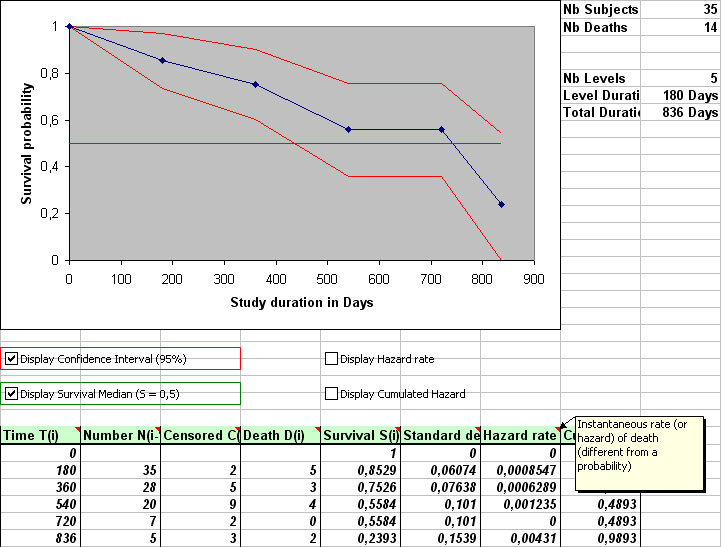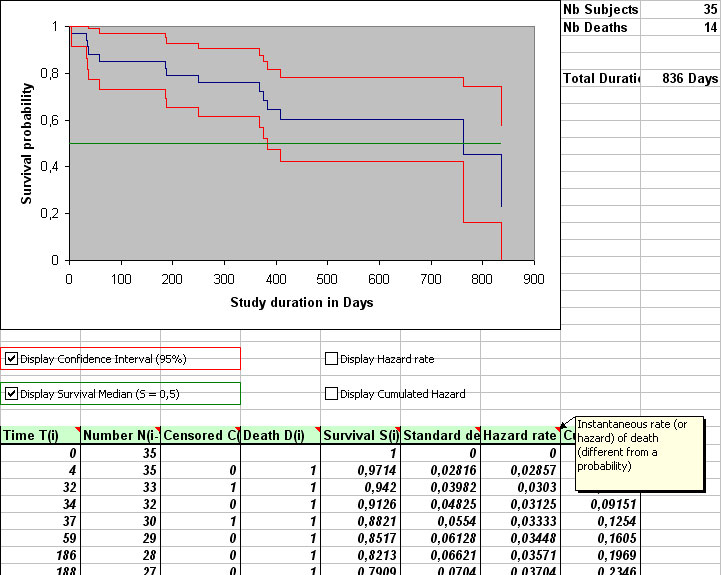| |
 |
StatEL : Survival Analysis
|
|
|
|
| |
This command launch construction procedure of a survival curve through actuarial method or Kaplan-Meier's method :
- actuarial method is preferable when studied effectives are important because it divides total duration of the study in constant intervals and calculate survival probability at the end of each interval,
- Kaplan-Meier's method is preferable when studied effectives are low because it takes into account every death to draw them on the curve and to induce a new level, so curve will be diffcult to interpret if there is a lot of death.
1 - Principle of a survival study :
A survival study leads to calculate variation of survival probability of patients from time t0. We add progressively new patients in the study and, at some times, we count number of alive patients, lost patients, and deceased patients due to studied pathology.
Nevertheless, patients do not integrate simultaneously (but progressively) survival study. However calculation methods use also information supplied by patients that came early in the study, as well as lost patients.
Actuarial method calculates survival probability only at some dates, previously organized. It neglects details of the study between 2 dates of calculation. On the contrary, Kaplan-Meier's method calculates a new survival probability after each death, every informations are then taken into account.
Due to its calculation way, actuarial method requires to respect a condition : that survival probability is independent from time, i.e. that survival probability is not modified by apparition, during study, of a new therapy susceptible to increase patients survival.
A survival study takes into account :
- the number of subjects that integrate the study (whatever the date of their entry),
- the number of subjects that are deceased during the study,
- the number of subjects that disappear from the study because they are lost, or they deceased because of another reason than the studied pathology : we speak about "censored" subjects.
For each subject, we have to know :
- their dates of entry and release from the study, or duration during which subject was maintained in the study,
- the reason or event that led to its release from survival study (dead, censored) .
Data format may be :
- either "Date of entry / Date of release" :
Nota bene : in this case, cells must be at "Date" format (cf. "Menu Format / Cell from Excel".
2 - Launch of a survival study
You must first specify the method you want to analyse survival study (actuarial or Kaplan-Meier).
Then, you must specify format of your study ("Date of entry / Date of release" or "Duration study" format). According to your response, data selection will be different.
2.1 - "Date of entry / Date of release" Format :
You have to select separately the cells range relative to dates of entry and realease of patients. You also have to select the cells range relative to events that justify release of patients from the study, as well as the code for "Death" event in this cells range ("D" in our exemple) :

Nota bene : every cells range selections must contain the same number of cells, if not, an error message will display.
Nota bene : if the code you specified to define "Death" event is not found in the "Event" variable selection, an error message will display.
2.2 - "Duration of study" Format :
You have to select the cells range relative to durations of study for every patients, and to specify if time unit is the day, month or year. You also have to select the cells range relative to events that justify release of patients from the study, as well as the code for "Death" event in this cells range ("D" in our exemple) :
Nota bene : every cells range selections must contain the same number of cells, if not, an error message will display.
Nota bene : if the code you specified to define "Death" event is not found in the "Event" variable selection, an error message will display.
Now you just have to click on the "Calculate and Draw" button.
3 - Resultats of a Survival Study
3.1 - Actuarial Method :
According to informations you specified about dates or study durations, StatEL is proposing you a calculated time interval. Survival calculations will be made at the end of each interval. You may change this time interval by modifying directely numerical value or by clicking on "Up/Down" arrows.
Results are displayed on a new Excel sheet and display selected data on the left part.
On the right part of results sheet, you can find survival curve, as well as numerical data that were used to its construction. Below the curve graph, several check boxes allow you to display on the graph :
- 95% confidence interval for survival probability (in red),
- the median of survival ; intersection of this line and survival curve give the time (or interval of time) for which survival probability is 0.5 (in green),
- hasard probability (of death) (in yellow),
- cumulated hasard (of death) (in brown).
Each point of the curve identifies end of an interval whose duration corresponds to the value you defined in the previous dialog box.
Nota bene : last interval may be shorter than the others.

At the right of the graph, major data of survival study are displayed :
- number of subjects of the study,
- number of deceased subjects,
- number of intervals used to divide survival study,
- duration of each interval (except the last one),
- total duration of the study
Table under the graph gathers numerical data required to construction of survival curve. Each column title can display a short comment that explains the content of the column.
3.2 - Kaplan-Meier's Method :
Results are displayed on a new Excel sheet and display selected data on the left part.
On the right part of results sheet, you can find survival curve, as well as numerical data that were used to its construction. Below the curve graph, several check boxes allow you to display on the graph :
- 95% confidence intervals for survival probability (in red),
- the median of survival ; intersection of this line and survival curve give the time (or interval of time) for which survival probability is 0.5 (in green),
- hasard probability (of death) (in yellow),
- cumulated hasard (of death) (in brown).
Each level of the curve is the death of a patient. Levels can be gathered or widely spread along the curve. This is why the Kaplan-Meier's method is few adapted to survival study with great effective.

At the right of the graph, major data of survival study are displayed :
- number of subjects of the study,
- number of deceased subjects,
- total duration of the study
Table under the graph gather numerical data required to construction of survival curve. Each column title can display a short comment that explains the content of the column.
|
|
|
| |
|
ad Science Company - 55, Boulevard Pereire, 75017 PARIS - France
|
|
|
|